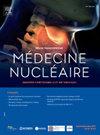人工智能辅助[18F]FDG PET/CT 定量:大 B 细胞淋巴瘤中一种节省时间的方法
IF 0.2
4区 医学
Q4 PATHOLOGY
Medecine Nucleaire-Imagerie Fonctionnelle et Metabolique
Pub Date : 2025-03-01
DOI:10.1016/j.mednuc.2025.01.142
引用次数: 0
摘要
目的评估ai辅助的[18F]FDG PET/CT分割是否显著缩短了大b细胞淋巴瘤(LBCL)患者总代谢肿瘤体积(TMTV)和两个病变之间最大距离(Dmax)的量化时间。方法在两家机构进行回顾性研究,纳入56例LBCL患者(Ann-Arbor分期:14%无疾病,25% I-II期,61% III-IV期)。比较了两种方法:人工智能辅助分割(Pionus®v1.1.0, PAIRE, Paris)通过专家纠正人工智能错误自动识别病变,而专家主导的分割则完全是手动的。两种方法都使用41%的SUVmax阈值。结果ai辅助分割速度快41%,平均每位患者节省104秒(152±134秒vs 255±270秒);0.001),节省的时间与TMTV相关(r = 0.67, P <;0.001)。两种方法的TMTV和Dmax均无显著差异。TMTV(0.91和0.95)和Dmax(0.97和0.95)的类内相关系数较高,具有较强的读者间一致性。结论人工智能辅助分割显著减少了LBCL患者TMTV和Dmax测量的时间,同时与人工方法相比保持了较高的可靠性和读者间一致性。本文章由计算机程序翻译,如有差异,请以英文原文为准。
AI-assisted [18F]FDG PET/CT quantification: A time-saving approach in large B-cell lymphoma
Purpose
To assess if AI-assisted segmentation on [18F]FDG PET/CT significantly reduces time in quantifying Total Metabolic Tumor Volume (TMTV) and the greatest distance between two lesions (Dmax) in large B-cell lymphoma (LBCL) patients.
Methods
A retrospective study at two institutions included 56 LBCL patients (Ann-Arbor staging: 14% with no disease, 25% stage I-II, 61% stage III-IV). Two methods were compared: AI-assisted segmentation (Pionus® v1.1.0, PAIRE, Paris) automatically identified lesions with expert correction of AI errors, while expert-led segmentation was fully manual. Both methods used a 41% SUVmax threshold.
Results
AI-assisted segmentation was 41% faster, saving an average of 104 seconds per patient (152 ± 134 seconds vs. 255 ± 270 seconds, P < 0.001), with time saved correlating with TMTV (r = 0.67, P < 0.001). No significant differences in TMTV or Dmax were found between methods. Intraclass correlation coefficients were high for both TMTV (0.91 and 0.95) and Dmax (0.97 and 0.95), with strong inter-reader agreement.
Conclusion
AI-assisted segmentation significantly reduces time for TMTV and Dmax measurement in LBCL patients, while maintaining high reliability and inter-reader agreement compared to manual methods.
求助全文
通过发布文献求助,成功后即可免费获取论文全文。
去求助
来源期刊
CiteScore
0.30
自引率
0.00%
发文量
160
审稿时长
19.8 weeks
期刊介绍:
Le but de Médecine nucléaire - Imagerie fonctionnelle et métabolique est de fournir une plate-forme d''échange d''informations cliniques et scientifiques pour la communauté francophone de médecine nucléaire, et de constituer une expérience pédagogique de la rédaction médicale en conformité avec les normes internationales.

 求助内容:
求助内容: 应助结果提醒方式:
应助结果提醒方式:


